Papers by Nuria Pelechano
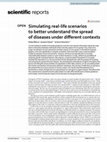
Scientific reports, Feb 1, 2024
Current statistical models to simulate pandemics miss the most relevant information about the clo... more Current statistical models to simulate pandemics miss the most relevant information about the close atomic interactions between individuals which is the key aspect of virus spread. Thus, they lack a proper visualization of such interactions and their impact on virus spread. In the field of computer graphics, and more specifically in computer animation, there have been many crowd simulation models to populate virtual environments. However, the focus has typically been to simulate reasonable paths between random or semi-random locations in a map, without any possibility of analyzing specific individual behavior. We propose a crowd simulation framework to accurately simulate the interactions in a city environment at the individual level, with the purpose of recording and analyzing the spread of human diseases. By simulating the whereabouts of agents throughout the day by mimicking the actual activities of a population in their daily routines, we can accurately predict the location and duration of interactions between individuals, thus having a model that can reproduce the spread of the virus due to human-to-human contact. Our results show the potential of our framework to closely simulate the virus spread based on real agent-to-agent contacts. We believe that this could become a powerful tool for policymakers to make informed decisions in future pandemics and to better communicate the impact of such decisions to the general public.

GREIL-Crowds: Crowd Simulation with Deep Reinforcement Learning and Examples
ACM Transactions on Graphics, Jul 26, 2023
Simulating crowds with realistic behaviors is a difficult but very important task for a variety o... more Simulating crowds with realistic behaviors is a difficult but very important task for a variety of applications. Quantifying how a person balances between different conflicting criteria such as goal seeking, collision avoidance and moving within a group is not intuitive, especially if we consider that behaviors differ largely between people. Inspired by recent advances in Deep Reinforcement Learning, we propose Guided REinforcement Learning (GREIL) Crowds, a method that learns a model for pedestrian behaviors which is guided by reference crowd data. The model successfully captures behaviors such as goal seeking, being part of consistent groups without the need to define explicit relationships and wandering around seemingly without a specific purpose. Two fundamental concepts are important in achieving these results: (a) the per agent state representation and (b) the reward function. The agent state is a temporal representation of the situation around each agent. The reward function is based on the idea that people try to move in situations/states in which they feel comfortable in. Therefore, in order for agents to stay in a comfortable state space, we first obtain a distribution of states extracted from real crowd data; then we evaluate states based on how much of an outlier they are compared to such a distribution. We demonstrate that our system can capture and simulate many complex and subtle crowd interactions in varied scenarios. Additionally, the proposed method generalizes to unseen situations, generates consistent behaviors and does not suffer from the limitations of other data-driven and reinforcement learning approaches.
arXiv (Cornell University), Nov 25, 2018
arXiv (Cornell University), Apr 11, 2023
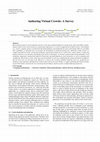
Computer Graphics Forum, May 1, 2022
Recent advancements in crowd simulation unravel a wide range of functionalities for virtual agent... more Recent advancements in crowd simulation unravel a wide range of functionalities for virtual agents, delivering highly-realistic, natural virtual crowds. Such systems are of particular importance to a variety of applications in fields such as: entertainment (e.g., movies, computer games); architectural and urban planning; and simulations for sports and training. However, providing their capabilities to untrained users necessitates the development of authoring frameworks. Authoring virtual crowds is a complex and multi-level task, varying from assuming control and assisting users to realise their creative intents, to delivering intuitive and easy to use interfaces, facilitating such control. In this paper, we present a categorisation of the authorable crowd simulation components, ranging from high-level behaviours and path-planning to local movements, as well as animation and visualisation. We provide a review of the most relevant methods in each area, emphasising the amount and nature of influence that the users have over the final result. Moreover, we discuss the currently available authoring tools (e.g., graphical user interfaces, drag-and-drop), identifying the trends of early and recent work. Finally, we suggest promising directions for future research that mainly stem from the rise of learning-based methods, and the need for a unified authoring framework.
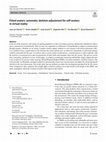
Virtual Reality
In the era of the metaverse, self-avatars are gaining popularity, as they can enhance presence an... more In the era of the metaverse, self-avatars are gaining popularity, as they can enhance presence and provide embodiment when a user is immersed in Virtual Reality. They are also very important in collaborative Virtual Reality to improve communication through gestures. Whether we are using a complex motion capture solution or a few trackers with inverse kinematics (IK), it is essential to have a good match in size between the avatar and the user, as otherwise mismatches in self-avatar posture could be noticeable for the user. To achieve such a correct match in dimensions, a manual process is often required, with the need for a second person to take measurements of body limbs and introduce them into the system. This process can be time-consuming, and prone to errors. In this paper, we propose an automatic measuring method that simply requires the user to do a small set of exercises while wearing a Head-Mounted Display (HMD), two hand controllers, and three trackers. Our work provides an...
2023 IEEE Conference Virtual Reality and 3D User Interfaces (VR)
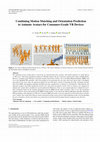
Computer Graphics Forum
The animation of user avatars plays a crucial role in conveying their pose, gestures, and relativ... more The animation of user avatars plays a crucial role in conveying their pose, gestures, and relative distances to virtual objects or other users. Self‐avatar animation in immersive VR helps improve the user experience and provides a Sense of Embodiment. However, consumer‐grade VR devices typically include at most three trackers, one at the Head Mounted Display (HMD), and two at the handheld VR controllers. Since the problem of reconstructing the user pose from such sparse data is ill‐defined, especially for the lower body, the approach adopted by most VR games consists of assuming the body orientation matches that of the HMD, and applying animation blending and time‐warping from a reduced set of animations. Unfortunately, this approach produces noticeable mismatches between user and avatar movements. In this work we present a new approach to animate user avatars that is suitable for current mainstream VR devices. First, we use a neural network to estimate the user's body orientati...
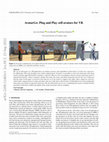
arXiv (Cornell University), Sep 23, 2022
The use of self-avatars in a VR application can enhance presence and embodiment which leads to a ... more The use of self-avatars in a VR application can enhance presence and embodiment which leads to a better user experience. In collaborative VR it also facilitates non-verbal communication. Currently it is possible to track a few body parts with cheap trackers and then apply IK methods to animate a character. However, the correspondence between trackers and avatar joints is typically fixed ad-hoc, which is enough to animate the avatar, but causes noticeable mismatches between the user's body pose and the avatar. In this paper we present a fast and easy to set up system to compute exact offset values, unique for each user, which leads to improvements in avatar movement. Our user study shows that the Sense of Embodiment increased significantly when using exact offsets as opposed to fixed ones. We also allowed the users to see a semitransparent avatar overlaid with their real body to objectively evaluate the quality of the avatar movement with our technique.

Users' locomotor behavior in collaborative virtual reality
Proceedings of the 11th Annual International Conference on Motion, Interaction, and Games, 2018
This paper presents a virtual reality experiment in which two participants share both the virtual... more This paper presents a virtual reality experiment in which two participants share both the virtual and the physical space while performing a collaborative task. We are interested in studying what are the differences in human locomotor behavior between the real world and the VR scenario. For that purpose, participants performed the experiment in both the real and the virtual scenarios. For the VR case, participants can see both their own animated avatar and the avatar of the other participant in the environment. As they move, we store their trajectories to obtain information regarding speeds, clearance distances and task completion times. For the VR scenario, we also wanted to evaluate whether the users were aware of subtle differences in the avatar's animations and foot steps sounds. We ran the same experiment under three different conditions: (1) synchronizing the avatar's feet animation and sound of footsteps with the movement of the participant; (2) synchronizing the animation but not the sound and finally (3) not synchronizing either one. The results show significant differences in user's presence questionnaires and also different trends in their locomotor behavior between the real world and the VR scenarios. However the subtle differences in animations and sound tested in our experiment had no impact on the results of the presence questionnaires, although it showed a small impact on their locomotor behavior in terms of time to complete their tasks, and clearance distances kept while crossing paths.

A Flexible Approach for Output‐Sensitive Rendering of Animated Characters
Computer Graphics Forum, 2011
Rendering detailed animated characters is a major limiting factor in crowd simulation. In this pa... more Rendering detailed animated characters is a major limiting factor in crowd simulation. In this paper we present a new representation for 3D animated characters which supports output‐sensitive rendering. Our approach is flexible in the sense that it does not require us to pre‐define the animation sequences beforehand, nor to pre‐compute a dense set of pre‐rendered views for each animation frame. Each character is encoded through a small collection of textured boxes storing colour and depth values. At runtime, each box is animated according to the rigid transformation of its associated bone and a fragment shader is used to recover the original geometry using a dual‐depth version of relief mapping. Unlike competing output‐sensitive approaches, our compact representation is able to recover high‐frequency surface details and reproduces view‐motion parallax effectively. Our approach drastically reduces both the number of primitives being drawn and the number of bones influencing each prim...
IEEE Computer Graphics and Applications
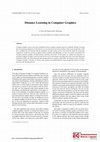
Computer graphic courses are pretty established in most computer graphics degrees worldwide. Dist... more Computer graphic courses are pretty established in most computer graphics degrees worldwide. Distance learning has been gaining popularity as fast internet access from home has been reaching wider areas around the world. If we combine this with the fact that the popularity of video games all over the world has made the technology required for rendering real time graphics widely available and affordable, we have the perfect environment for teaching computer graphics through distance learning universities. In this paper, we explain our experience in teaching Computer Graphics basics for the last 10 years at the distance teaching university Universitat Oberta de Catalunya (UOC). By using materials that include interactive applets which allow the student to play with basic Computer Graphics concepts, we observe that students can understand the course despite the teacher not being present in the learning process.
This paper presents our first experience teaching WebGL in a master’s degree for a class of stude... more This paper presents our first experience teaching WebGL in a master’s degree for a class of students with very different backgrounds. The main challenge was to prepare a course that would be engaging for students with computer graphics experience, and yet interesting and non-frustrating for those students unfamiliar with OpenGL. In this paper we explain how we prepared this course, and the project assignment to achieve our goal. The results achieved by the students show that the course succeeded in keeping different kinds of students engaged and excited with the implementation of their final project.
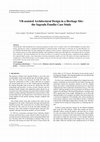
Virtual Reality (VR) simulations have long been proposed to allow users to explore both yet-to-bu... more Virtual Reality (VR) simulations have long been proposed to allow users to explore both yet-to-built buildings in architectural design, and ancient, remote or disappeared buildings in cultural heritage. In this paper we describe an on-going VR project on an UNESCO World Heritage Site that simultaneously addresses both scenarios: supporting architects in the task of designing the remaining parts of a large unfinished building, and simulating existing parts that define the environment that new designs must conform to. The main challenge for the team of architects is to advance towards the project completion being faithful to the original Gaudí’s project, since many plans, drawings and plaster models were lost. We analyze the main requirements for collaborative architectural design in such a unique scenario, describe the main technical challenges, and discuss the lessons learned after one year of use of the system. CCS Concepts •Computing methodologies → Virtual reality; •Human-centere...
Per-joint impostors have been used to achieve high performance when rendering thousands of agents... more Per-joint impostors have been used to achieve high performance when rendering thousands of agents, while still allowing us to blend animation. This provides interactively animated crowds and reduces the memory footprint compared to classic impostors. In this poster we exploit the potential of per joint impostors to further increase both visual quality and performance. The CAVAST framework for crowd simulation and rendering has been used to quantitatively evaluate our improvements with the profiling tools that it provides. Since different applications will have different requirements in terms of performance vs. visual quality, we have extended CAVAST with a new user interface to ease this process.
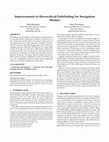
Proceedings of the Tenth International Conference on Motion in Games, 2017
The challenge of path-finding in video games is to compute optimal or near optimal paths as effic... more The challenge of path-finding in video games is to compute optimal or near optimal paths as efficiently as possible. As both the size of the environments and the number of autonomous agents increase, this computation has to be done under hard constraints of memory and CPU resources. Hierarchical approaches, such as HNA* can compute paths more efficiently, although only for certain configurations of the hierarchy. For other configurations, performance can drop drastically when inserting the start and goal position into the hierarchy. In this paper we present improvements to HNA* to eliminate bottlenecks. We propose different methods that rely on further memory storage or parallelism on both CPU and GPU, and carry out a comparative evaluation. Results show an important speed-up for all tested configurations and scenarios. CCS CONCEPTS • Computing methodologies → Planning with abstraction and generalization; Intelligent agents;
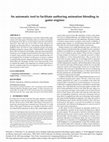
Motion, Interaction and Games, 2019
Achieving realistic virtual humans is crucial in virtual reality applications and video games. No... more Achieving realistic virtual humans is crucial in virtual reality applications and video games. Nowadays there are software and game development tools, that are of great help to generate and simulate characters. They offer easy to use GUIs to create characters by dragging and drooping features, and making small modifications. Similarly, there are tools to create animation graphs and setting blending parameters among others. Unfortunately, even though these tools are relatively user friendly, achieving natural animation transitions is not straight forward and thus non-expert users tend to spend a large amount of time to generate animations that are not completely free of artefacts. In this paper we present a method to automatically generate animation blend spaces in Unreal engine, which offers two advantages: the first one is that it provides a tool to evaluate the quality of an animation set, and the second one is that the resulting graph does not depend on user skills and it is thus not prone to user errors. CCS CONCEPTS • Computing methodologies → Animation; • Software and its engineering → Interactive games;
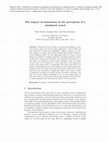
Advances in Computer Graphics, 2021
Simulating virtual crowds is an important challenge in many areas such as games and virtual reali... more Simulating virtual crowds is an important challenge in many areas such as games and virtual reality applications. A lot of effort has been dedicated to improving pathfinding, collision avoidance, or decision making, to achieve more realistic human-like behavior. However, crowd simulation will be far from appearing realistic as long as virtual humans are limited to walking animations. Including animation variety could greatly enhance the plausibility of the populated environment. In this paper, we evaluated to what extend animation variety can affect the perceived level of realism of a crowd, regardless of the appearance of the virtual agents (bots vs. humanoids). The goal of this study is to provide recommendations for crowd animation and rendering when simulating crowds. Our results show that the perceived realism of the crowd trajectories and animations is significantly higher when using a variety of animations as opposed to simply having locomotion animations, but only if we render realistic humanoids. If we can only render agents as bots, then there is no much gain from having animation variety, in fact, it could potentially lower the perceived quality of the trajectories.

Towards a human-like approach to path finding
Computers & Graphics, 2021
Path finding for autonomous agents has been traditionally driven by finding optimal paths, typica... more Path finding for autonomous agents has been traditionally driven by finding optimal paths, typically by using A* search or any of its variants. When it comes to simulating virtual humanoids, traditional approaches rarely consider aspects of human memory or orientation. In this work, we propose a new path finding algorithm, inspired by current research regarding how the brain learns and builds cognitive maps. Our method represents the space as a hexagonal grid with counters, based on brain research that has investigated how memory cells are fired. Our path finder then combines a method for exploring unknown environments while building such a cognitive map, with an A* search using a modified heuristic that takes into account the cognitive map. The resulting paths show how as the agent learns the environment, the paths become shorter and more consistent with the optimal A* search. Moreover, we run a perceptual study to demonstrate that the viewers could successfully identify the intended level of knowledge of the simulated agents. This line of research could enhance the believability of autonomous agentsâ€TM path finding in video games and other VR applications.











Uploads
Papers by Nuria Pelechano